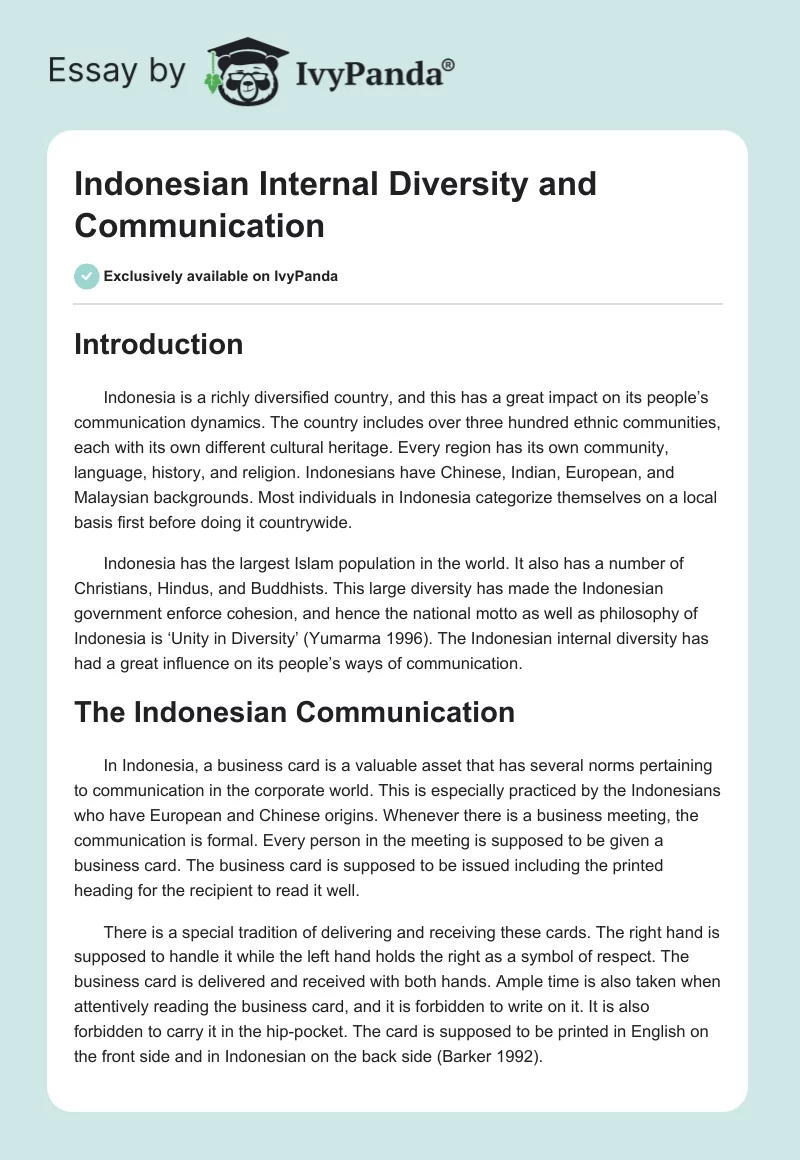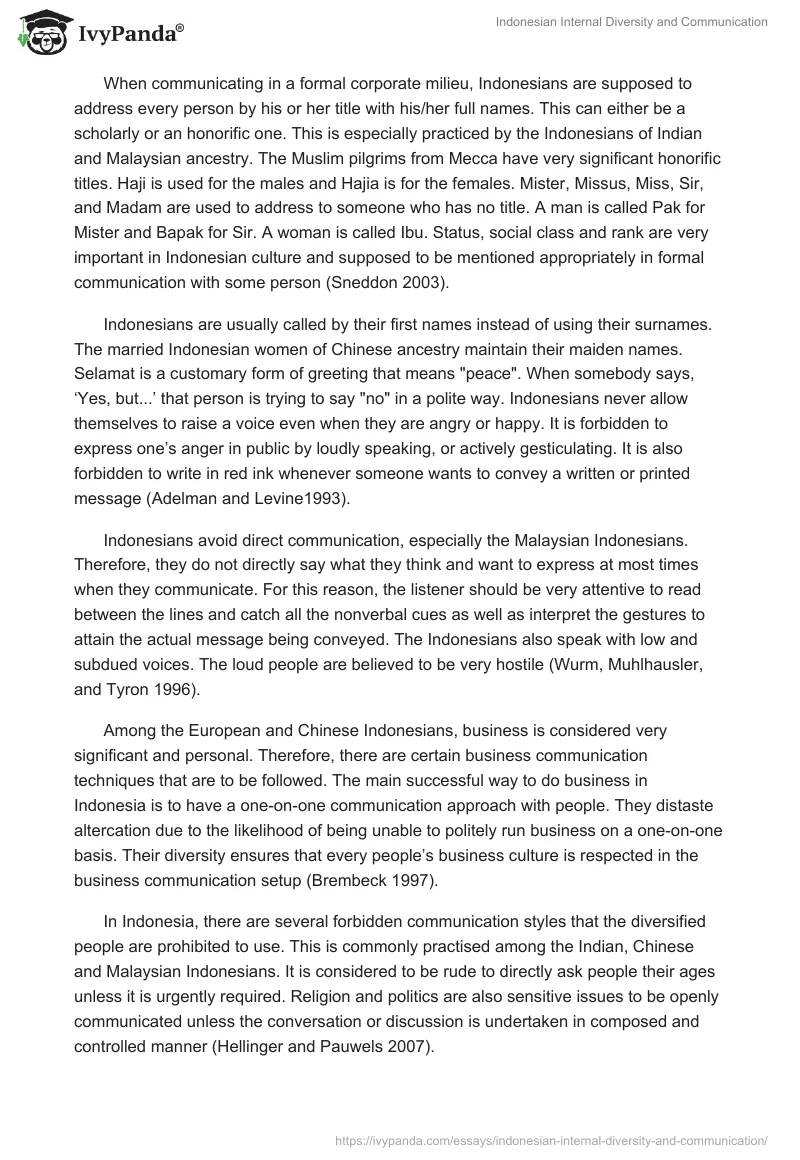Introduction
Indonesia is a richly diversified country, and this has a great impact on its people’s communication dynamics. The country includes over three hundred ethnic communities, each with its own different cultural heritage. Every region has its own community, language, history, and religion. Indonesians have Chinese, Indian, European, and Malaysian backgrounds. Most individuals in Indonesia categorize themselves on a local basis first before doing it countrywide.
Indonesia has the largest Islam population in the world. It also has a number of Christians, Hindus, and Buddhists. This large diversity has made the Indonesian government enforce cohesion, and hence the national motto as well as philosophy of Indonesia is ‘Unity in Diversity’ (Yumarma 1996). The Indonesian internal diversity has had a great influence on its people’s ways of communication.
The Indonesian Communication
In Indonesia, a business card is a valuable asset that has several norms pertaining to communication in the corporate world. This is especially practiced by the Indonesians who have European and Chinese origins. Whenever there is a business meeting, the communication is formal. Every person in the meeting is supposed to be given a business card. The business card is supposed to be issued including the printed heading for the recipient to read it well.
There is a special tradition of delivering and receiving these cards. The right hand is supposed to handle it while the left hand holds the right as a symbol of respect. The business card is delivered and received with both hands. Ample time is also taken when attentively reading the business card, and it is forbidden to write on it. It is also forbidden to carry it in the hip-pocket. The card is supposed to be printed in English on the front side and in Indonesian on the back side (Barker 1992).
When communicating in a formal corporate milieu, Indonesians are supposed to address every person by his or her title with his/her full names. This can either be a scholarly or an honorific one. This is especially practiced by the Indonesians of Indian and Malaysian ancestry. The Muslim pilgrims from Mecca have very significant honorific titles. Haji is used for the males and Hajia is for the females. Mister, Missus, Miss, Sir, and Madam are used to address to someone who has no title. A man is called Pak for Mister and Bapak for Sir. A woman is called Ibu. Status, social class and rank are very important in Indonesian culture and supposed to be mentioned appropriately in formal communication with some person (Sneddon 2003).
Indonesians are usually called by their first names instead of using their surnames. The married Indonesian women of Chinese ancestry maintain their maiden names. Selamat is a customary form of greeting that means “peace”. When somebody says, ‘Yes, but…’ that person is trying to say “no” in a polite way. Indonesians never allow themselves to raise a voice even when they are angry or happy. It is forbidden to express one’s anger in public by loudly speaking, or actively gesticulating. It is also forbidden to write in red ink whenever someone wants to convey a written or printed message (Adelman and Levine1993).
Indonesians avoid direct communication, especially the Malaysian Indonesians. Therefore, they do not directly say what they think and want to express at most times when they communicate. For this reason, the listener should be very attentive to read between the lines and catch all the nonverbal cues as well as interpret the gestures to attain the actual message being conveyed. The Indonesians also speak with low and subdued voices. The loud people are believed to be very hostile (Wurm, Muhlhausler, and Tyron 1996).
Among the European and Chinese Indonesians, business is considered very significant and personal. Therefore, there are certain business communication techniques that are to be followed. The main successful way to do business in Indonesia is to have a one-on-one communication approach with people. They distaste altercation due to the likelihood of being unable to politely run business on a one-on-one basis. Their diversity ensures that every people’s business culture is respected in the business communication setup (Brembeck 1997).
In Indonesia, there are several forbidden communication styles that the diversified people are prohibited to use. This is commonly practised among the Indian, Chinese and Malaysian Indonesians. It is considered to be rude to directly ask people their ages unless it is urgently required. Religion and politics are also sensitive issues to be openly communicated unless the conversation or discussion is undertaken in composed and controlled manner (Hellinger and Pauwels 2007).
The diversified Indonesian culture forbids other people to be insensitive to their international journey experiences. They believe that only they are allowed to talk about their experience and not supposed to be engulfed by other people’s stories. It is also forbidden to give or obtain something using the left hand because it is deemed disrespectful and impolite. Instead, people should give and take things with their right hand or with both hands. In the rural regions, especially in Java, giving or receiving something with both hands, bowing down to some extent at the same time, is considered ideal to show one’s respect for another person.
It is also not allowed to put one’s hands on the hips when talking to somebody else. That position is considered for someone who is prepared to fight and viewed as a threat to some extent. They also bow and offer a handshake when greeting people. This is very common with Indonesian Chinese. Women are forbidden to offer a handshake to men, but males can extend their hand when greeting females. They greet in no haste as it is considered to be formal and vital (Kitley 2000).
The European Indonesians also value their personal and social space. When expatriates have business meetings with Indonesians, they may back away aiming at resuming their personal space but Indonesians move closer to them to uphold their social space. Indonesians also consider a direct eye contact to be impolite. People may look at one’s chin or in the eyes only for very short periods otherwise they feel very uncomfortable while having a conversation. Indonesians do not touch people when speaking to them, it may be allowed only in communication with friends and acquaintances of the same gender. Indonesians abstain from doing so when communicating with people of the opposite sex or professional colleagues (Jackson and Pye 1980).
Australian Influence on Indonesian Communication
In my opinion, the low context culture of Australia influences the way in which people communicate with Indonesians, in particular. Australia and Indonesia are countries which have a reasonable proximity to each other. For this reason, the Australians who have the low context communication are regular tourists and business people in Indonesia. They largely and frequently communicate with the Indonesians. This has had a great influence on the low context communication patterns with Indonesians (Errington 1980).
Reference List
Adelman, Mara and Deena Levine. 1993. Beyond Language: Cross-Cultural Communication. New Jersey: Prentice Hall Regents.
Barker, John. 1992. Practical Indonesian: a communication guide. New York: New York University Press.
Brembeck, Winston. 1997. “The Development and Teaching of a College Course in Intercultural Communication.” In Readings in Intercultural Communication, November, 1-115. Pittsburgh, University of Pittsburgh: SIETAR Publications.
Errington, Joseph J. 1986. “Continuity and change in Indonesian languages development.” Journal of Asian Studies 45(2): 329-353.
Hellinger, Marlis and Pauwels Anne. 2007. Handbook of language and communication: diversity and change. New York: Mouton de Gruyter Publishers.
Jackson, Karl and Lucian Pye. 1980. Political power and communications in Indonesia. Berkeley: University of California Press.
Kitley, Philip. 2000. Television, nation, and culture in Indonesia. Athens: Ohio University Center for International Studies.
Sneddon, James Neil. 2003. Indonesian language: its history and role in modern society. Sydney: University of New South Wales Press.
Wurm, Stephen Adolphe, Muhlhausler, Peter, and Darrel Tyron. 1996. Atlas of languages and intercultural communication in the Pacific, Asia, and the Americas. Berlin, New York: Mouton de Gruyter Publishers.
Yumarma, Andreas. 1996. Unity in diversity: a philosophical and ethical study of the Javanese concept. Rome, Gregoriana: Pontificia University Press.


